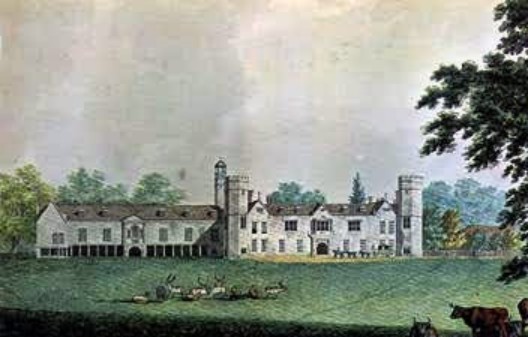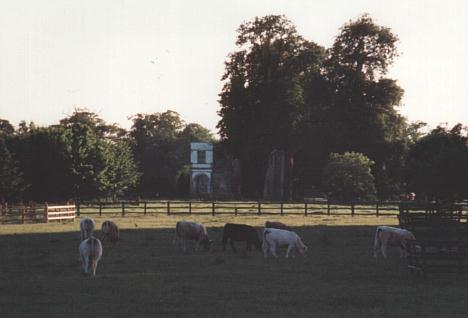The Gorhambury Estate - that is the lands and manors associated with the Manor of Gorhambury Westwick & Prae, and under the control of the Lord of that manor, has extended beyond the boundaries of the original manor of Westwick into several neighbouring manors, including Redbourne. By the beginning of this century hundreds of acres in this part of Hertfordshire belonged wholly to the Earls of Verulam; indeed by the late eighteenth century much of the copyhold and freehold property in the manors had been acquired by the Grimstons so that as Lords of the manor they now held the absolute freehold to the property, thus enabling the estate to be managed as one unit. It is, however, the importance of the Gorhambury estate to the immediate area around Leverstock Green that is of concern here.
Prior to the dissolution, apart from the two centuries when it was in the hands of firstly the de Gorham family, and then the de Vere family, the manors around Gorhambury were under the control of one of the most powerful monastic foundations in the country - the Benedictine Abbey of St. Albans.
After the dissolution, the estate was granted in 1541 to a fashionable merchant and wealthy London Goldsmith - Sir Ralph Rowlatt. Twenty years later the estate was bought by Sir Nicholas Bacon. Sir Nicholas' second wife, Ann Cooke was sister-in-law to Ralph Rowlatt, son of the original owner of the estate, and who by this time had inherited.
On taking over the estate, which included the medieval manor house inhabited by the Rowlatts, Sir Nicholas Bacon decided to make Gorhambury their home. Its proximity to the court and London, together with the pleasant landscape of the area made it ideal. However, wanting a more modern residence, Sir Nicholas Bacon, Lord Keeper of the Great Seal of England, decided to build a new modern house.
In the construction of this new house between 1563 and 1568, Sir Nicholas employed local workmen. Although many of the workforce would have come from St. Albans, it is highly probable that some at least of the labourers would have come from the dwellings around Westwick Row. At the very least, the local inhabitants would have benefited from the increased prosperity brought to the area by the new house and its owner, who occupied a high position in society and was of national importance.
Photograph taken in 1996 showing the present remains of Bacon's Gorhambury:
Queen Elizabeth I was a frequent visitor at Gorhambury, and these occasions must at the very least have caused the inhabitants around Westwick Row with food for gossip., and possibly with additional work. On the occasion of the Queen's visit in 1577, the total bill for the four day stay of the Queen and her retinue was £577 6s 7d farthing - about one third of what it had cost Bacon to build Gorhambury.
In 1569, Sir Nicholas Bacon commissioned a survey of all his manors and estates. This is the earliest document we have for this area written in English, and it provides a wealth of information, giving us an extremely clear "snap shot" picture of all the lands and farmsteads in his lordship, and therefore much of this area. It also provides information on the previous history of the area in the footnotes made after each entry.
The 1569 survey records whether or not property was part of Sir Nicholas' immediate estate of Gorhambury, or whether it was owned freehold or copyhold by others. It also recorded their names, and the size and names of individual fields and their relative position to one another. The survey is beautifully preserved and as easy to read today as it was when it was written over 400 years ago.
The survey shows very clearly that in 1569, with the exception of one or two small areas of woodland, the whole area was highly cultivated. Settlement was concentrated around Westwick Row, although not exclusively so. Property was largely held in copyhold from the manor, although again not exclusively. The actual demesne estate attached to Gorhambury, that is the land owned and administered wholly by Sir Nicholas Bacon, was therefore quite small, and can be seen quite clearly on the Benjamin Hare map of 1633, when things had changed little. The only property in our immediate vicinity to be part of the demesne of Gorhambury, was the farm let to Henry Knight in 1569, and situated along Westwick Row roughly where Westwick Warren is today. The small field opposite, in which the great tithe barn stood, (built for the Abbey), was also in his demesne.
This survey portrayed a long established and prosperous farming community in the area, but as yet no "village" of Leverstock Green.
The Gorhambury estates passed to Bacon's wife Ann, and eventually to their younger son Francis. Sir Francis Bacon, like his father, was a Statesman, being at one stage in his career Lord Chancellor, as well as being one of the finest minds in the country. He was a philosopher, lawyer, poet, essayist and experimental scientist, carrying out many of his experiments when staying at Gorhambury. He is considered by many to be the real author of Shakespeare's plays and poems; using the name Shakespeare as a nom de plume based on a pun, and using the glover from Stratford as a front to mask his real identity.
After Sir Francis' death in 1626, the estate was eventually acquired by his long-time friend Sir Thomas Meautys. Sir Thomas's widow (who incidently was the daughter of Sir Nathaniel Bacon of Culford, and a great grand-daughter of Sir Nicholas Bacon), married Sir Harbottle Grimston, who purchased the reversion of the manors of Gorhambury, Westwick, Kingsbury and Prey for £10,000 from Henry Meautys, Sir Thomas' brother and heir. Gorhambury thus became the property of the Grimston family, with whom it has remained ever since.
Once more the Gorhambury estates, and therefore much of the area around Leverstock Green, belonged to a man of considerable talents and national standing. Sir Harbottle Grimston being at one time elected Speaker of the House of Commons, and shortly after the Restoration, being appointed Master of the Rolls. It was during his tenure at Gorhambury that much of the property around Westwick Row, as well as Breakspears, Blackwater Farm and Market Oak, reverted to his freehold, thereby bringing a large proportion of the farming land in the Leverstock Green area under the direct control of the Grimston family at Gorhambury. The many documents which have survived from this period show that the land was carefully husbanded, and prospered.
Many of the farmsteads were rebuilt or extended at this time, including Breakspears, Kettlewells, Westwick Row Farm, Westwick Corner and both Stonehall and Hillend Farm. Sir Harbottle Grimston also caused Westwick Hall to be built in 1658, thereby moving the "home farm" for the estate from Westwick Row to nearer Gorhambury. His roll as Master of the Rolls possibly also led to his meticulous keeping of records on the estate. One such is a delightful survey undertaken in 1668, which also included some charming sketch maps of the various farmsteads, together with the layout of their fields.
The estate eventually fell to William Luckyn, the adopted heir, and great-nephew of Sir Samuel Grimston, Harbottle's son. Changing his name to Grimston and marrying an heiress, William was able keep the estate prosperous through the early years of his ownership, and was created Viscount Grimston in 1719. During William's time too, development had been allowed to take place, and the village of Leverstock Green, with its smithy, cottages and pubs such as the Leather Bottle, developed around and even on the green.(Church Cottages) The majority of the original village of Leverstock Green was almost wholly within the Gorhambury estate.
Unfortunately, by the time he died at the age of 92 in 1756, several of his younger children had milked the estate. His granddaughter, Charlotte Grimston, later wrote:
Fortunately James, the 2nd Viscount, also married an heiress, and once again the estate was under careful management, with the necessary financial backing. In 1767 a further survey of his estates was commissioned by Lord Grimston, so that once again we have a perfect snapshot of the area at that time. This time, as well as a highly meticulous written field survey, there is an accompanying map.
In 1775, initiated by the 3rd Viscount and his wife, the new palladian style mansion at Gorhambury started to be built. The main block was finished by 1784, but additional wings were not added until 1789-90. Bacon's Gorhambury (now badly disintegrating) was looted for bricks and other materials to infill behind the stone facade. As in Bacon's time, the building of such an elegant mansion must not only have provided work for the local inhabitants during the building, but also provided employment for many local girls in particular "in service" once it was complete. Such a magnificent house would have needed a large workforce to maintain it.
As the village of Leverstock Green grew, and when increasing industrialisation brought with it the need for bricks, the long established but small scale brickworkings in the area also grew. This led to an increase in the local population, and the eventual need for a church of its own in Leverstock Green. In this, the Gorhambury Estate was very helpful, giving the land on which to build the church, as well as the Vicarage; in addition the 2nd Earl of Verulam (James Grimston), provided much of the money needed to build the church. To this day the tree decorated and put up in Holy Trinity at Christmas time comes from the Gorhambury Estate as a gift. The same Earl of Verulam did much to consolidate the Gorhambury estate, purchasing considerable amounts of land in and around St. Albans and doing much to improve the various farm buildings and cottages on the estate, including building a new farmhouse at Kettlewells. (The 17th century farmhouse built by Harbottle Grimston was eventually carefully demolished, sold and rebuilt at Bricket Wood in the 1980's.)
The 2nd Earl also bought Westwick Farm in November 1854, noting in his diary:
He obviously completely despaired of the old Tudor Farmhouse and had it demolished and the present farmhouse built a few years later. The footings of the old farmhouse were uncovered during an extension built in recent years.
Despite their own financial difficulties following the Wall Street Crash in 1929, in the 1930's, more much needed land for a village building was provided by the Gorhambury estate. This time it was land in Pancake Lane, known then as Bluebell Wood, and on which was to be built the new village school.
It was also at this time that the majority of the farmland belonging to Gorhambury was sold - and much of it became part of the Crown Estate. This included all the land in and around Leverstock Green. Although with the developments since the 1930's, the M1 and the New Town of Hemel Hempstead, much of this land is now either privately owned or part of the property belonging to Englsh Partnerships (the New Towns Commission), the majority of the remaining farming land is still part of the Crown Estate's Gorhambury Estate -the extent of which can be seen from the Estate Map.The land the Leverstock Green Scout Headquarters is built on is also still part of the Crown's Gorhambury Estate.

